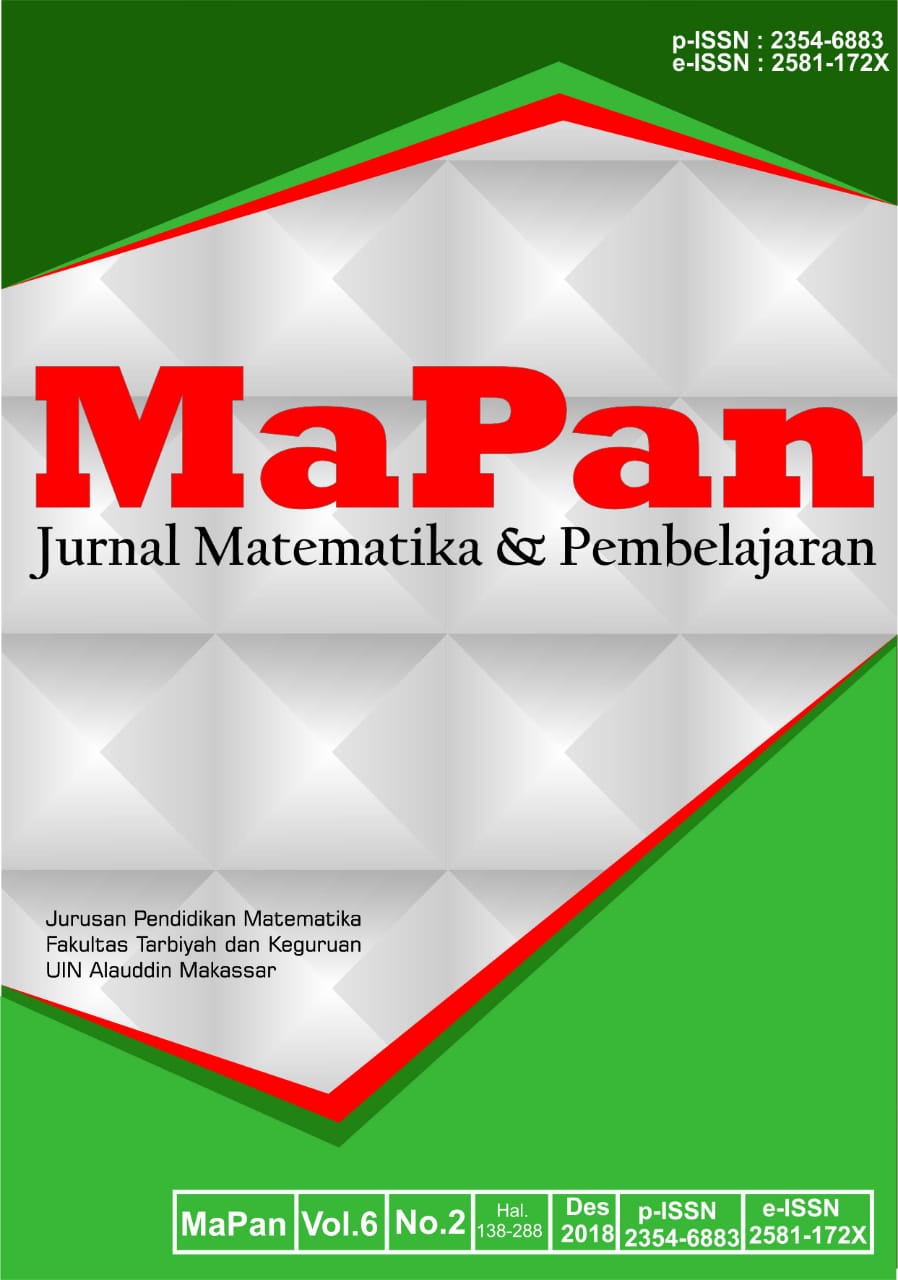HUBUNGAN ANTARA KEMAMPUAN NUMERIK DENGAN KEMAMPUAN PEMECAHAN MASALAH MATEMATIS SISWA DI PEDESAAN
Abstract
Abstrak:
Penelitian ini bertujuan untuk mengetahui hubungan antara kemampuan numerik dengan kemampuan pemecahan masalah matematika siswa di daerah pedesaan. Penelitian ini menggunakan penelitian korelasional dengan populasi siswa kelas VIII SMP Negeri 1 Cibal yang terletak di Kecamatan Cibal Kabupaten Manggarai, Propinsi Nusa Tenggara Timur yang berjumlah 458 siswa. Sampel sebanyak 214 siswa dipilih dengan menggunakan teknik random sampling. Data diperoleh dari tes kemampuan pemecahan masalah matematika dan tes kemampuan numerik yang kemudian dianalisis dengan teknik analisis product moment. Analisis dan interpretasi data menunjukkan bahwa terdapat hubungan yang cukup kuat kemampuan numerik dengan kemampuan pemecahan masalah matematika siswa pedesaan. Selain itu, terdapat hubungan yang positif dan signifikan antara kemampuan numerik dengan kemampuan pemecahan masalah matematika. Kontribusi kemampuan numerik terhadap kemampuan pemecahan masalah matematika siswa sebesar.
Abstract:
The study aims to determine the correlation between numerical abilities and mathematical problem-solving abilities of the students in rural area. This study used correlational research with a population of eighth-grade students of SMP Negeri 1 Cibal of Manggarai regency, the Province of east Nusa Tenggara with total number of 458 students. The sample of 214 students had been selected by using random sampling technique. The data were obtained from mathematical problem-solving ability test and numerical ability tests, the data were then analyzed by using product moment analysis techniques. The analysis and interpretation of the data showed that: (1) the correlation between numerical ability and mathematical problem solving ability of the students in rural area was strong enough; (2) there was a positive and significant relationship between numerical ability and mathematical problem-solving ability. The contribution of numerical ability to the students' mathematical problem-solving ability was 17.64%.
Downloads
References
Badru, A. K. (2016). Problem-based instructional strategy and numerical ability as determinants of senior secondary achievement in mathematics. Journal of Education and Practice, 7(13), 89–95. Retrieved from https://files.eric.ed.gov/fulltext/EJ1102799.pdf
Cahyono, T. D., Masykuri, M., & Ashadi. (2016). Kontribusi kemampuan numerik dan kreativitas terhadap prestasi belajar siswa pada materi pokok hidrolisis kelas XI MIA1 dan XI MIA5 SMA Negari 2 Karanganyar tahun pelajaran 2015/2016. Jurnal Pendidikan Kimia (JPK), 5(2), 81–88. Retrieved from http://jurnal.fkip.uns.ac.id/index.php/kimia/article/view/8374/6145
Carter, P. (2005). The complete book of intelligence tests. England: Wiley.
Cragg, L., & Gilmore, C. (2014). Skills underlying mathematics: The role of executive function in the development of mathematics proficiency. Trends in Neuroscience and Education, 3(2), 63–68. Retrieved from https://www.sciencedirect.com/science/article/pii/S2211949313000422
Eviyanti, C. Y., Surya, E., Syahputra, E., & Simbolon, M. (2017). Improving the students’ mathematical problem solving ability by applying problem based learning model in VII grade at SMPN 1 Banda Aceh Indonesia. International Journal of Novel Research, 4(2), 138–144. Retrieved from https://www.researchgate.net/publication/318529138_Improving_the_Students’_Mathematical_Problem_Solving_Ability_by_Applying_Problem_Based_Learning_Model_in_VII_Grade_at_SMPN_1_Banda_Aceh_Indonesia
Fazio, L. K., Bailey, D. H., Thompson, C. A., & Siegler, R. S. (2014). Relations of different types of numerical magnitude representations to each other and to mathematics achievement. Journal of Experimental Child Psychology, 123, 53–72. Retrieved from http://www.psy.cmu.edu/~siegler/2014-Fazioetal.pdf
Fuadi, I., Minarni, A., & Banjarnahor, H. (2017). Analysis of students’ mathematical problem solving ability in IX grade at Junior High School Ar-Rahman Percut. International Journal of Novel Research in Education and Learning, 4(2), 153–159. Retrieved from https://www.researchgate.net/profile/Ihsan_Fuadi3/publication/319207497_ANALYSIS_OF_STUDENTS%27_MATHEMATICAL_PROBLEM_SOLVING_ABILITY_IN_IX_GRADE_AT_JUNIOR_HIGH_SCHOOL_AR-RAHMAN_PERCUT/links/599bdfc10f7e9b892bad25a4/ANALYSIS-OF-STUDENTS-MATHEMATICAL-PROBLE
Graham, S. E., & Provost, L. E. (2012). Mathematics achievement gaps between suburban students and their rural and urban peers increase over time. Carsey Institute, (52), 1–8. Retrieved from https://files.eric.ed.gov/fulltext/ED535962.pdf
Gunur, B., Sariyasa, & Ardaa, I. M. (2016). Pengaruh pendidikan matematika realistik terhadap kemampuan pemecahan masalah matematika ditinjau dari kemampuan numerik siswa SMP Negeri 1 Cibal. Jurnal Pendidikan Dan Pembelajaran Matematika Indonesia, 5(1). Retrieved from http://119.252.161.254/e-journal/index.php/JPM/article/view/2129
Indrawati, F. (2013). Pengaruh kemampuan numerik dan cara belajar terhadap prestasi belajar matematika. Jurnal Formatif, 3(3), 215–223. Retrieved from http://journal.lppmunindra.ac.id/index.php/Formatif/article/download/126/122
Kryst, E. L., Kotok, S., & Bodovski, K. (2015). Rural/urban disparities in science achievement in post-socialist countries: The evolving influence of socioeconomic status. Global Education Review, 2(4), 60–77. Retrieved from http://ger.mercy.edu/index.php/ger/article/download/179/156
Lagur, D. S., Makur, A. P., & Ramda, A. H. (2018). Pengaruh model pembelajaran kooperatif tipe numbered head together terhadap kemampuan komunikasi matematis. Mosharafa: Jurnal Pendidikan Matematika, 7(3), 357–368. Retrieved from https://journal.institutpendidikan.ac.id/index.php/mosharafa/article/download/mv7n3_5/pdf
Libertus, M. E., Feigenson, L., & Halberda, J. (2013). Numerical approximation abilities correlate with and predict informal but not formal mathematics abilities. Journal of Experimental Child Psychology, 116(4), 829–838. Retrieved from https://www.ncbi.nlm.nih.gov/pmc/articles/pmc3796771/
Makur, A. P., Prahmana, R. C. I., & Gunur, B. (2018). Kemampuan berpikir tingkat tinggi, peserta osk matematika tingkat sd, dan strategi think, talk, and write. Jurnal Pendidikan Matematika, 12(2), 23–32. Retrieved from https://ejournal.unsri.ac.id/index.php/jpm/article/view/5677
National Council of Teachers Mathematics. (2000). Principle and standart for school mathematics. Reston, VA: NCTM.
Ramda, A. H., Prahmana, R. C. I., Mulu, H., & Gunur, B. (2018). Kemampuan konservasi panjang pada siswa usia 6-7. Jurnal Gantang, 3(2), 109–116. Retrieved from http://ojs.umrah.ac.id/index.php/gantang/article/download/480/400
Saragih, S., & Habeahan, W. L. (2014). The improving of problem solving ability and students’ creativity mathematical by using problem based learning in SMP Negeri 2 Siantar. Journal of Education and Practice, 5(35), 123–133. Retrieved from https://pdfs.semanticscholar.org/ec0c/da5b3869a46dab53bfc471dd5d782ca74f56.pdf
Suherman, E. (2001). Strategi pembelajaran matematika kontemporer. Bandung: JICA-UPI.
Suparlan, A. J. (2009). Pengaruh minat dan kecerdasan numerik terhadap prestasi belajar matematika siswa. EduMa, 1(2), 129–137. Retrieved from https://anzdoc.com/pengaruh-minat-dan-kecerdasan-numerik-terhadap-prestasi-bela.html
Utami, R. W., & Wutsqa, D. U. (2017). Analisis kemampuan pemecahan masalah matematika dan self-efficacy siswa SMP Negeri di Kabupaten Ciamis. Jurnal Riset Pendidikan Matematika, 4(2), 166–175. Retrieved from https://journal.uny.ac.id/index.php/jrpm/article/view/14897/10186
Copyright (c) 2018 Bedilius Gunur, Alberta Parinters Makur, Apolonia Hendrice Ramda

This work is licensed under a Creative Commons Attribution 4.0 International License.


